THE MANY ADVENTURES OF WINNIE THE POOH

Welcome to Revisiting Disney! Today, we’re looking at The Many Adventures of Winnie the Pooh, a film that was probably a part of most of our collective childhoods! Like always, I have labeled each category so if you want to skip to the parts that interest you most, feel free. And, of course, if you have any thoughts, burning or otherwise, please share in the comments!
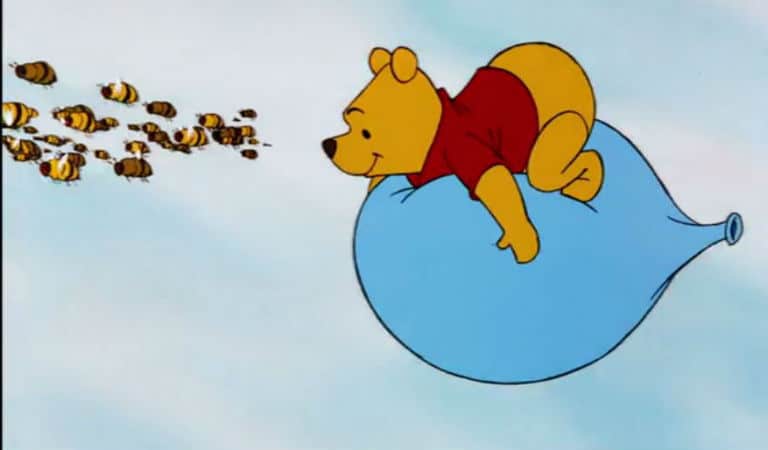
BACKGROUND
For me, we’re getting into the portion of the Disney canon that is more nostalgic. I don’t know about you, but these are the movies that I watched growing up.
With the story by eight men, including veteran story guys Ken Anderson and Larry Clemmons, The Many Adventures of Winnie the Pooh is made up of several segments that had been released separately. In many ways, it’s similar to the package films or anthology films of the War years.
Released on March 11th, 1977 in the US, this film is a combination of three short films, all produced at different times in the studios’ history. With this in mind, it’s a different sort of film than the ones that came before (or after) it.
The stories include Winnie the Pooh and the Honey Tree (1966), Winnie the Pooh and the Blustery Day (1968), and Winnie the Pooh and Tigger Too (1974). Since the stories were all released at different times, the time-in was done by having the pages turn in the book, with an interaction between the narrator and some of the characters (mainly Pooh).
The narrator is voiced by Sebastian Cabot (who voiced Bagheera in The Jungle Book), Christopher Robin is voiced in one segment by Bruce Reitherman (who had voiced Arthur/Wart in The Sword in the Stone), and Winnie the Pooh is voiced by Sterling Holloway (who voiced Kaa in The Jungle Book, as well as doing other work for the Studio).
MUSIC
The music for The Many Adventures of Winnie the Pooh was composed by Buddy Baker, who had done work for Disney previously and would also work on The Fox and the Hound. The music and lyrics were by my personal favorite songwriting sibling duo, Richard and Robert Sherman.
The music is simple, catchy, and has just the right amount of bounce. The songs are the kind that kids love to sing, and the lyrics are clever enough to not drive adults’ nuts. Even on this rewatch, I found the songs enjoyable and loved that they seemed to include several puns.
ANIMATION
The animators behind The Many Adventures of Winnie the Pooh were the usual guys, Milt Kahl, Ollie Johnston, Eric Larson, John Lounsbery, and Frank Thomas, with Hal King and Eric Cleworth, Gary Goldman, and Don Bluth (among others). Wolfgang Reitherman, again, was the producer, and he and John Lounsbery directed the film.
Originally, the animators wanted to just use the backgrounds in the books, because they are very pretty, but Walt wanted the film to have a distinct Disney-flair to it, so he requested that the animators put their own spin on Ernest H. Shepard’s animation.
The result is a lovely and simplistic design. The backgrounds are set up like the background illustrations in children’s books, and often they and the characters are interacting with the text.
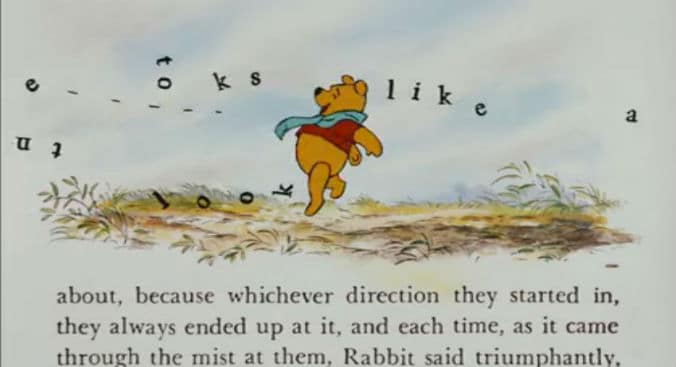
The story is set up in a fun way as well. The characters are part of the book and as the narrator tells the story, we can see the characters moving as the illustrations around the words (or, later, the words blowing away).
The Many Adventures of Winnie the Pooh is the kind of movie that you watch and think that the animators must have had a lot of fun working on. The lines are crisp and the characters and backgrounds are clearly separate from each other while still interacting.
Even though the three shorts are from different times in the studio’s history, and the film was made in another, they still all fit together. And that, I think, is quite cool, showcasing the skills of the team.
THE PLOT
The opening is really clever. As we are getting ready to start the stories, we see the credits over a real room of a real child, including stuffed animal versions of the characters in the movie. The narrator talks about the room and Christopher Robin for a minute, before we move to the first story, Winnie the Pooh and the Honey Tree, and open the book. There, we hear the theme song and see a map of the 100 Acre Wood, outlining where all the characters are.
Pooh, sitting in front of his house, hears his clock and realizes it’s time to exercise, which makes him hungry. He finds that he is out of honey, and begins his schemes to find some. He tries to climb a tree to get honey, but it doesn’t go the way he has planned it to.
In an effort to disguise himself from the bees, he borrows a blue balloon from Christopher Robin and disguises himself as a rain cloud. The bees catch on, and Pooh and Christopher Robin end up running away to avoid being stung.
Finally, Pooh goes to Rabbit’s House, where they have lunch. Pooh eats all the honey Rabbit has and proceeds to get stuck in the front door. Christopher Robin is consulted and, when trying to pull Pooh out doesn’t work, decides that they need to wait until he is thinner. Rabbit tries to make the best of it while keeping Pooh from eating.

Finally, Pooh is unstuck, only to fly through the air and get stuck again, this time in a honey tree. The story ends and we start the next one, Winnie the Pooh and the Blustery Day.
Because it is a blustery day, Piglet starts to blow away, because he is so small. Pooh catches him, and the two of them end up at Owl’s House. When Owl’s house is destroyed in the storm, Eeyore sets out to find a new house for his friend. Meanwhile, the wind continues (the blustery day turns into a blustery night).
Pooh hears a new sound, and, as the narrator tells us, being a bear of very little brain, opens the door to let the new noise into his house. It ends up being Tigger, who sings his wonderful song that we all remember.
Tigger is new to the 100 Acre Wood, and he makes himself memorable (he was always one of my favorite characters as a kid). After he tells Pooh that heffalumps and wozzles steal honey, Pooh decides to keep watch, and when he falls asleep, has a nightmare about heffalumps and wozzles. In a lot of ways it reminds me of the Pink Elephant song from Dumbo, it’s very surreal.
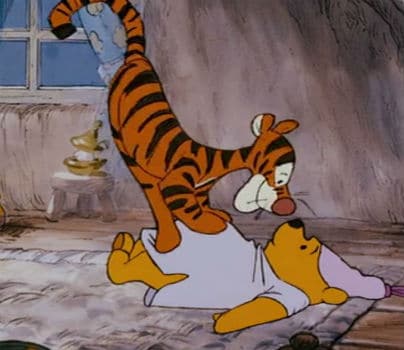
The story continues with a rainstorm, which leads to a flood. Everyone makes it to Christopher Robin’s house, but Piglet is stuck in the flood on a chair while Pooh is stuck in a honey pot. Piglet sends out a message in a bottle and tries to paddle his chair to shore, but does not have any luck. Pooh saves Piglet from drowning during the flood, so they throw a hero party.
During Pooh’s hero party, Eeyore is excited to have found a new house for Owl. When it turns out that Eeyore has found Piglet’s house, a house that Piglet loves very much, Piglet gives up his house for his friend. Pooh informs his best friend that he can live with him.
In the third and final short, Winnie the Pooh and Tigger Too, Rabbit is tired of Tigger’s bouncing, so he hatches a plan to take the bounce out of Tigger, and ropes in Pooh and Piglet to help.
They decide to take a walk in the Woods and lose Tigger, hoping that being lost would take the bounce out of him. Of course, it doesn’t work, and Rabbit ends up getting lost. Tigger finds him, because Tiggers don’t get lost, and bounces him out of the mist.
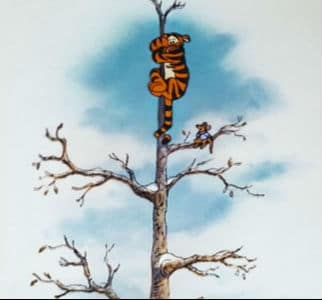
When bouncing with Roo some time later, Tigger gets stuck in a tree after bouncing too high. While trying to get down, he promises to never bounce again if he can get down. Rabbit hears and is very excited. When Tigger does get down (with the help of the narrator), Rabbit intends to hold him to his word, but when he sees how sad that makes Tigger, he changes his mind. The story ends with Christopher Robin telling Pooh not to forget home when he goes to school, because he’ll be back, and with that, the book closes.
SOURCE MATERIAL
The Many Adventures of Winnie the Pooh is based on a series of books written by A.A. Milne and illustrated by Ernest H. Shepard. The books to many of us might be just as nostalgic as the movie and the television show, focusing on characters and situations that we have grown to know and love.
Milne wrote the stories for his son, Christopher Robin Milne, who had a favorite bear named Winnie at the London Zoo. This bear was also the namesake for Christopher’s stuffed bear, and some of the other characters were also toys belonging to the boy. Others, like Owl and Rabbit, were animals that lived on the family’s country estate in Sussex.
The Sussex estate, Cotchford Farm, was the inspiration for the 100 Acre Wood. Milne began writing the Pooh stories in 1925. They were so popular that they have been translated into over 40 languages, and he wrote numerous stories and poems about Pooh and his friends between 1925 and 1928. He passed away in 1996 and left his mark on children’s literature.
THE 1970’s
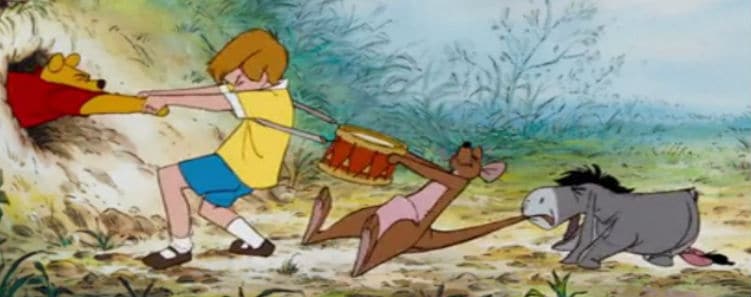
Photo: Disney
This film threw me for a loop, which is ironic given that the 1970’s threw everyone for a loop. Basically, since the film is a collection of shorts released in the late ’60’s and early ’70’s, but compiled together in the late ’70’s, it’s a bit disjointed. For me, that means that it’s not truly a film of the ’70’s, so we’ll finish up this decade next week.
A quick refresher, therefore, on the late 60’s and early 70’s. It was not a time of peace. We were striving for it, but marginalized groups were struggling for equality, there were wars and anti-war movements. People wanted to get back to the ’50’s because they thought we had moved too far in the wrong direction while others thought we hadn’t moved enough.
Both decades were a time of conflict and confusion, and into that time, a film like this one that is light, humorous, simplistic and catchy, but has morals and things that can teach children, is a good balance. The lessons learned can be carried on while also providing much-needed laughter in a time that was full of serious issues.
LESSONS LEARNED
The first lesson is, don’t be greedy. Pooh eats too much honey and gets stuck in Rabbit’s door. He has to stay there until he is small enough to become unstuck, teaching kids that it’s important to practice moderation. At least, that’s what I learned from it.
Secondly, think outside the box. Pooh wanted to get the honey, but the bees wouldn’t let him. His solution was to disguise himself as a rain cloud, get a blue balloon, and float up. He would pretend to not be a threat and lull the bees into a false sense of security. It didn’t work, but he still gets points for trying something original.
Thirdly, being a hero isn’t always easy. Pooh was a hero for saving Piglet during the flood, which was fairly easy for him. Piglet, however, was a hero because he gave up his beloved house for a friend. It wasn’t easy, but it was worth it. Owl had a place to live, and Piglet’s friends stepped up to help him out.
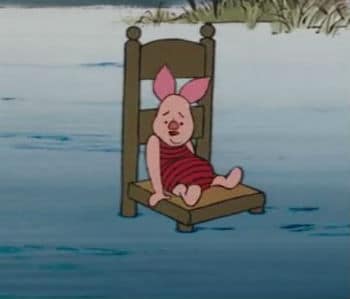
Finally, it’s important to know when to ask for help, and it’s okay to do so. Everyone goes to Christopher Robin for help, whether they’re stuck, without honey, a house falls down or they need their tails reattached. Tigger saves Rabbit, Pooh saves Piglet, Eeyore finds a house for Owl. They all help each other, and that’s a good lesson.
DOES IT HOLD UP?
Despite being released in parts both before and after this 1977 film, based on the number of kids I knew growing up who were watching these shorts (if not the whole thing), it was a success. Not only did this film exist, but there was also a Christmas special and a television show, which is probably still in reruns on some cable channels.
Winnie the Pooh is one of those characters that most of us remember fondly, and in this series of shorts, three of his most endearing tales are packaged together in a new way. Each short is only 20 minutes or so, but if you have 75 minutes to spare, there are worse things to introduce to a new generation of kids than this delightful anthology.
For next week: The Rescuers
If you enjoyed this post and the others in the Revisiting Disney series, and have found yourself wishing that you could find them all in one convenient and bound book with eight extra essays, there is an option for you! Check out A Journey Through Disney: My Look Back Through Disney Canon, now available on Amazon as both a Kindle book ($4.99) and a paperback ($11.99).
OTHER SOURCES:
http://www.history.com/topics/1970s
http://studioservices.go.com/disneystudios/history.html
https://thewaltdisneycompany.com/about-disney/disney-history
Bailey, Adrian. Walt Disney’s World of Fantasy. Everest House Publishers. New York, New York. 1982.
Finch, Christopher. The Art of Walt Disney: From Mickey Mouse to the Magic Kingdom. Harry N. Abrams, Inc. New York, New York. 1975.
Sale, Roger. Fairy Tales and After: From Snow White to E.B. White. Harvard University Press. Cambridge, MA, 1978.
Tatar, Maria. The Annotated Classic Fairy Tales. W.W. Norton and Company. New York and London, 2002.
Thomas, Frank. Disney’s Art of Animation From Mickey Mouse to Hercules. Hyperion. New York, New York. 1992.
Wright, Gordon. The Ordeal of Total War: 1939-1945. Harper Torchbooks, Harper & Row. New York, Hagerstown, San Francisco, and London, 1968.
ARE YOU A ROMANCE FAN? FOLLOW THE SILVER PETTICOAT REVIEW:
 Our romance-themed entertainment site is on a mission to help you find the best period dramas, romance movies, TV shows, and books. Other topics include Jane Austen, Classic Hollywood, TV Couples, Fairy Tales, Romantic Living, Romanticism, and more. We’re damsels not in distress fighting for the all-new optimistic Romantic Revolution. Join us and subscribe. For more information, see our About, Old-Fashioned Romance 101, Modern Romanticism 101, and Romantic Living 101.
Our romance-themed entertainment site is on a mission to help you find the best period dramas, romance movies, TV shows, and books. Other topics include Jane Austen, Classic Hollywood, TV Couples, Fairy Tales, Romantic Living, Romanticism, and more. We’re damsels not in distress fighting for the all-new optimistic Romantic Revolution. Join us and subscribe. For more information, see our About, Old-Fashioned Romance 101, Modern Romanticism 101, and Romantic Living 101.

Comments are closed.